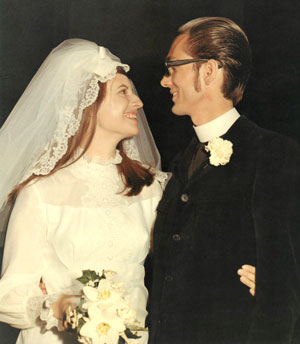 In May 2019, we celebrated the 50th anniversaries of Frederic and Mary Ann Brussat: their wedding and their shared work. They got married on May 24, 1969, and within a week they started what would become a lifelong vocation of helping people explore cultural events through the vital lens of the world's religions and spiritual paths. This work, in its varying forms, has animated them ever since, up to their present roles as Co-Founders and Co-Directors of Spirituality & Practice.
In May 2019, we celebrated the 50th anniversaries of Frederic and Mary Ann Brussat: their wedding and their shared work. They got married on May 24, 1969, and within a week they started what would become a lifelong vocation of helping people explore cultural events through the vital lens of the world's religions and spiritual paths. This work, in its varying forms, has animated them ever since, up to their present roles as Co-Founders and Co-Directors of Spirituality & Practice.
We want to share the fascinating evolution of the Brussats' work with you, but five decades worth of their projects means lots to include. We have parceled their evolving vision into five chapters and want to start way back in the mimeograph days.
Chapter 1: Cultural Information Service (1969 - 1986)
Right after their wedding, Frederic and Mary Ann moved to New York City, knowing that with their interests in the arts and media, it was where they needed to be. They soon launched their first publication, Cultural Information Service (CIS). The name described the seven areas of its contents. An "Americana section" covered cultural events and trends. Other sections included reviews of Television, Film, Art, Literature-Criticism, Theater, and Youth-Rock. The first "issues" were mimeographed using a different color paper for each area of content.
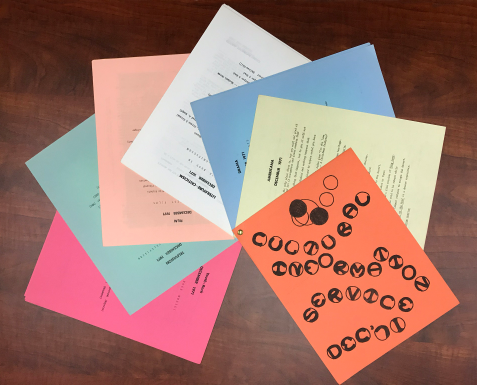
The audience for their work (which has broadened over the years) was "teachers and preachers" actively engaged in "relating the living Word to the happening world." They described Cultural Information Service as a "monthly rendezvous with serious art which offers us opportunities to deepen our perceptions, expand our vision, and enliven our imagination." Setting the tone for all their work, CIS evaluated cultural events thematically. It also reflected one of the Brussats' favorite pieces of advice: "Be sober and clear-eyed with a thousand eyes in every direction." (St. Chrysostum)
Frederic remembers the challenges of those first years working together:
"We used to joke that we were able to come to New York with no jobs and dream up our own career because I could read fast and Mary Ann could type fast. But what was really important was that we were interested in so many things. We had degrees in history, philosophy, religion, and political science; I was committed to encouraging appreciation of the arts and the media, and Mary Ann followed current events. Creating a service to deliver information on what was happening in the culture was a natural direction for us.
"We set out to establish contacts in New York's media and arts industries. And soon we learned that they didn't understand why a minister and his wife, writing primarily for other religious folk, wanted to review in their area. I remember calling up the record companies to request promotional copies of new releases. "Oh, you must want the classical department," they'd say. "No, I want to cover The Doors and the Rolling Stones," I told them. Trying to get on screening lists for movies, I'd be told that "We don't really have very many religious films; maybe next spring for Easter."
"But by being persistent, we did get on review copy and movie screening lists and also got tickets to plays. One night I decided to wear my clerical collar to the Broadway opening of "The Trial of the Catonsville Nine"; I had worked with Daniel Berrigan at Cornell and wanted to be in solidarity with his anti-war protests. We were seated behind a row of critics we often saw at screenings for popular Hollywood movies and Broadway musicals. The critic for New York magazine was looking around and spotted me in my collar. He did a double take with the most surprised expression on his face! I was glad to make that witness!"
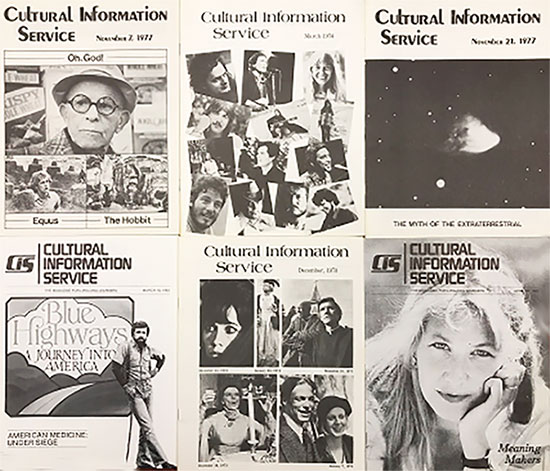
After the Brussats set up a nonprofit organization and received a grant, they were able to print CIS. They sent copies to other publications. One editor wrote: "The magazine is impressive in its breadth of subject matter and comprehensive coverage, but I am concerned that it is produced by two people. How long can the Brussats keep this up?" The answer: 50 years and counting . . .
Here's another comment about the Brussats' first publication:
"CIS makes me tired. It makes me tired to think of all the energy that has to be put into monitoring the media. But it also refreshes me, to see the Church showing such positive interests in low and high culture, and to think of the way in which CIS editors simplify life for busy, open-minded lay and clerical Christians. A good idea, and a better reality!"
— Martin Marty, American religious scholar
Chapter 2: Living Room Learning and Viewer's Guides (1978 – 1995)
Early on, Frederic discovered that he really liked to review television shows and movies by asking questions about their themes. In Cultural Information Service, he wrote two or three discussion guides a month for The FEEDFORWARD Series, including an annual guide to the feature films that would show on TV during the season. These used a movie, book, or TV show as a "launch pad" to move a group into reflections on how the media event related to the viewers' lives.
After the Brussats sent copies of this creative approach to their contacts at the television networks, they were asked to write educational campaigns for the networks' Community Relations Departments. Before long, they were working with NBC, ABC, CBS, PBS, and some of the corporate sponsors developing Viewer's Guides, posters, bookmarks, bulletin inserts, and even newspaper supplements for movies-of-the-week, miniseries, children's programming, and news series. Whereas previously this kind of material had only been distributed to local TV stations and schools, the Brussats convinced them to also send them to churches, professional associations, libraries, and community groups.
Remember "Holocaust," "Jesus of Nazareth," "The Long Search," "Centennial," "Shogun," "The Blue and the Gray," "The Winds of War," "Space," "Bill," "Two of a Kind," "Summer Solstice," "The Best Little Girl in the World," "Kent State," "The Miracle Worker," "Little Lord Fauntleroy," "The American Short Story," "Project Peacock," and "The Day After"? The Brussats wrote the guides for all of them — and many more programs — sometimes at the rate of four a month.
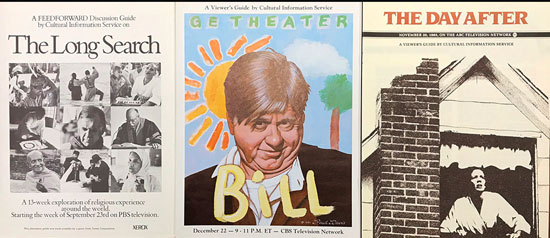
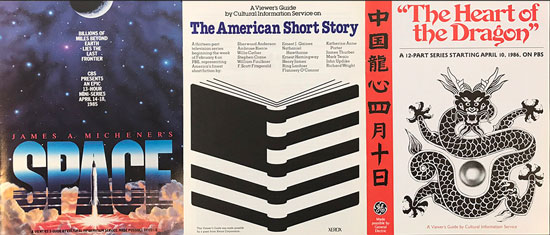
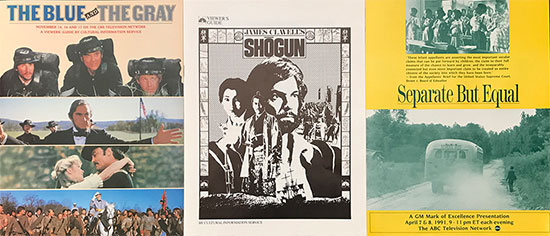
Seeing the response to the guides, Mary Ann decided that what they were really encouraging was informal learning by adults and their families and friends in the comfort and convenience of their homes — i.e. living room learning. They replaced the Cultural Information Service newsletter with two new ones: one focusing on Reviews and Overviews and another on Previews and Program Ideas; later these were combined in a newsletter called Living Room Learning. The section heads will give you an idea of its scope and focus: Human Touches in Movies and Books, Moral Mentors, Going Global, Meaning Makers, Table Talk, Homegrown Ethics, Naming the Days (still going today), Behind Today's Headlines, and Soul Food.
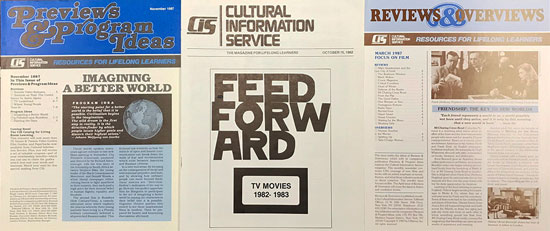
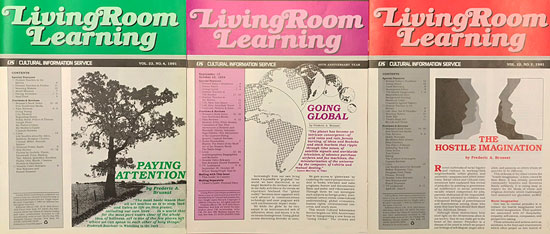
Frederic remembers this chapter of their work:
"Writing educational campaigns around TV shows was a great opportunity and a great challenge for me. I had to quickly get up to speed on historical events (the Revolutionary War, the Civil War, World War II, the Vietnam War — so many wars!) and social issues (alcoholism, teen suicide, AIDS, drunk driving, anorexia, living with disabilities, and others). These projects were before cable TV, when the four major networks captured most of the viewing audience. A TV movie or miniseries was what everybody was talking about around the water cooler the next day. We got out information about these shows before the airdate so that teachers and group leaders knew what to expect.
"The response was very fulfilling. We heard from school teachers who organized units around a multi-night miniseries and used our plot synopsis and discussion questions to connect the program to their curriculum. The social-issue movies raised awareness and gave people information on where to find resources and support groups. ![]()
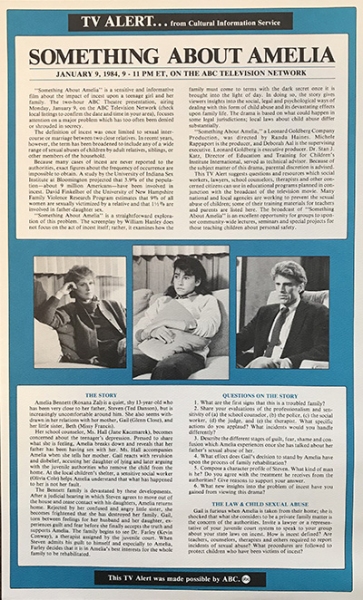 "For example, we worked on the first television show to deal with incest: 'Something About Amelia.' Ted Danson, then a major TV star, played a father who was abusing his daughter. The story gave viewers insights into the social, legal, and psychological ways of dealing with this form of child abuse and its devastating effects upon family life. We sent a TV Alert to social workers and school counselors all over the country, giving a plot synopsis of the show, a bibliography, and information on treatment and prevention strategies from organizations working on the problem. The day after the TV movie aired, Mary Ann's brother called. He was a social worker at a community health clinic at the time. He said, 'Well, sure glad you told me about that TV show.' 'Why?' I asked. 'Because I had three new incest cases on my desk this morning. The girls blurted out what was happening to their mothers in the middle of the movie.' That's the power of the media."
"For example, we worked on the first television show to deal with incest: 'Something About Amelia.' Ted Danson, then a major TV star, played a father who was abusing his daughter. The story gave viewers insights into the social, legal, and psychological ways of dealing with this form of child abuse and its devastating effects upon family life. We sent a TV Alert to social workers and school counselors all over the country, giving a plot synopsis of the show, a bibliography, and information on treatment and prevention strategies from organizations working on the problem. The day after the TV movie aired, Mary Ann's brother called. He was a social worker at a community health clinic at the time. He said, 'Well, sure glad you told me about that TV show.' 'Why?' I asked. 'Because I had three new incest cases on my desk this morning. The girls blurted out what was happening to their mothers in the middle of the movie.' That's the power of the media."
Chapter 3: Values & Visions (1991 – 1996)
Values & Visions was the name of three projects Frederic and Mary Ann Brussat launched in the 1990s. The Values & Visions Reviews Service provided reviews to other publications and media outlets. Earlier, the Brussats had written for such church publications as A.D., The Messenger, Youth Magazine, The Lutheran, and Lutheran Women Today. Now they provided film and movie reviews to Ecumedia, an ecumenical news service; Body, Mind, Spirit magazine; and the Ecunet computer network. They began a new column on "Spiritual Practices" for The Lutheran. They provided movie reviews to VISN TV and later Mary Ann was the film reviewer for the "New Morning" TV show on the Hallmark Channel. When Trinity Church Wall Street began to publish Spirituality & Health magazine in the mid-1990s, the Brussats became the first Media Reviewers and then the Website Editors.
As they began to do fewer TV Viewer's Guides, the Brussats amped up their work with small groups, developing materials for "Values & Visions Circles." Groups could draw from a catalog of more than 200 Values & Visions Guides — all designed to turn film viewing and book reading into times for self-exploration and personal growth, encouraging people to exercise their values, clarify their commitments, and recognize intimations of grace in their everyday lives.
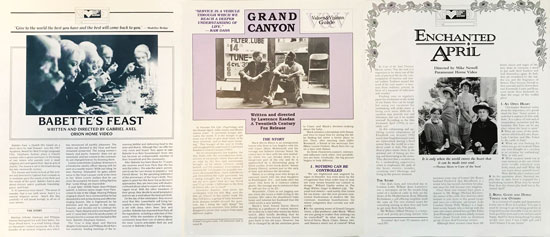
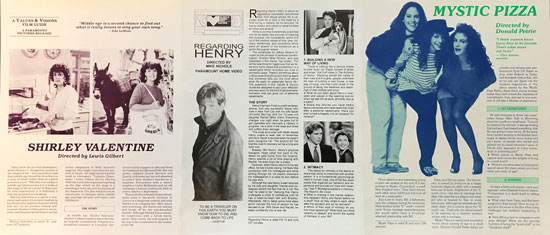
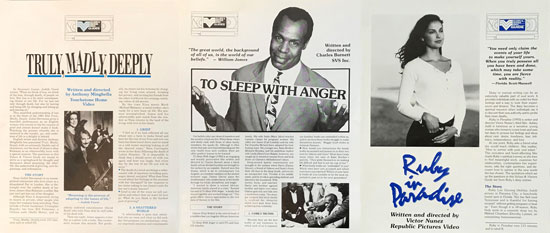
The Brussats' newsletter during this chapter of their work was Values & Visions. They continued to review films, books, audios, and TV programs, but began to use these cultural events as the starting points for thematic reflections on contemporary values and visions with an emphasis on those reflecting the widespread spirituality of the times. They decided that people needed a "resource companion" for their spiritual journeys. They organized their recommendations around themes: Relationships, Children's Spirituality, Spiritual Elders, Creativity, Rituals, The Soul of Place, The Soul of Animals, and more.
Subscribers were excited about this approach. Spiritual philosopher Sam Keen wrote: "I don't know of any other publication that is so adept at tracking down the sacred in the nooks and crannies of our popular culture." Child psychologist Robert Coles wrote: "Values & Visions offers a broad look at an important matter, our moral and spiritual life." Retreat director Robert Raines said: "Values & Visions is the single richest treasurehouse of commentary on stories, films, audios, videos, and contemporary literature that I know. The Brussats seek and find spirituality, grace, and the presence of the Spirit in everyday, ordinary people and situations." Presbyterian minister Bryant Kirkland wrote: "The Brussats are masters in the fine art of finding thought-provoking and fresh quotations. This publication is my best preaching assistant." Justine Toms of New Dimensions Radio observed: "Not one of us has the time to look into every published item regarding the spiritual path so this concise and creative commentary helps point us to the appropriate material at the appropriate moment." Here's what journalist Bill Moyers said:
"Our culture is awash with trivia, nonsense, and violence. But in the media morass, we can find artists and writers who do care about the life of the spirit and enduring wisdom. The editors of Values & Visions are publishing the most original and refreshing guide to what's truly valuable in American society."
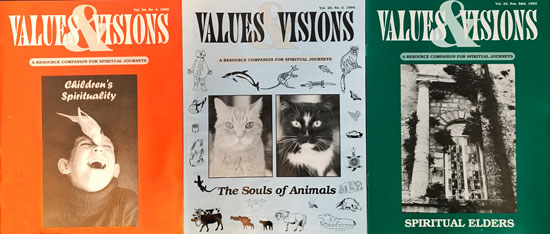
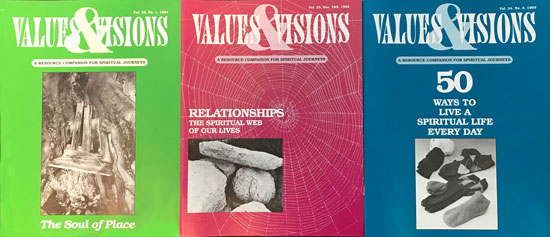
Frederic remembers this chapter of their work:
"Values & Visions was really a turning point for us. We'd been very eclectic in our reviewing, and then the TV Viewer's Guide programs took us into a diverse range of subject areas. With V&V we started to organize our focus on what we saw as a spiritual renaissance beginning in the early '90s. We began to 'curate' our content (curation is a popular term these days, but back then it was usually associated with art exhibitions and museums). We published thematic issues and usually began them with collections of short passages taken from the books we were reviewing.
"We turned one of those special issues into a gift book, 100 Ways to Keep Your Soul Alive, which was followed by 100 More Ways to Keep Your Soul Alive. Another issue presented "50 Ways to Live a Spiritual Life Every Day." One of the editors of Utne Reader spotted it and asked to reprint it. A book editor at Scribner saw that piece and invited us in to talk about doing a gift book. She asked us if we had any more selections of brief passages like those, and we laid out the issues of Values & Visions on the table. One thing led to another — until in November 1996 our book Spiritual Literacy was published."
Chapter 4: Spiritual Literacy and Spiritual Rx (1996 - present)
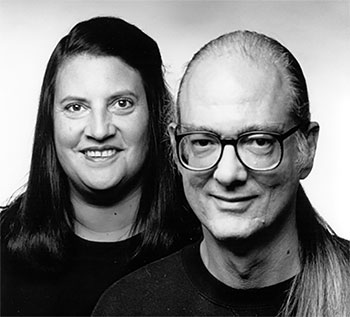 Spiritual Literacy by Frederic and Mary Ann Brussat was published by Scribner in November 1996. (The photo here was taken for its release.) The book consists of more than 650 "readings" that reveal a spiritual take on everyday experiences. The Brussats collected them from books they had reviewed by spiritual teachers, essayists, novelists, naturalists, poets, and activists. They added in stories from their personal experiences and their interpretations of contemporary movies, songs, and television dramas.
Spiritual Literacy by Frederic and Mary Ann Brussat was published by Scribner in November 1996. (The photo here was taken for its release.) The book consists of more than 650 "readings" that reveal a spiritual take on everyday experiences. The Brussats collected them from books they had reviewed by spiritual teachers, essayists, novelists, naturalists, poets, and activists. They added in stories from their personal experiences and their interpretations of contemporary movies, songs, and television dramas.
"Life is a sacred adventure," they wrote. "Every day we encounter signs that point to the active presence of Spirit in the world around us. Spiritual literacy is the ability to read the signs written in the texts of our own experiences." Spiritual literacy is a skill, they added, and it is learned by illustration and example.
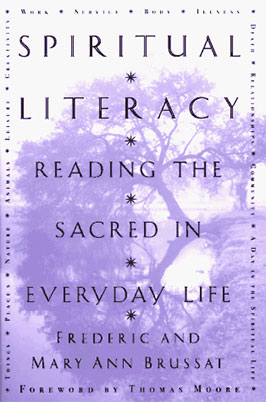 Thomas Moore, author of Care of the Soul, wrote in the foreword that the book "is aimed at restoring lost bonds of spirit and matter, body and mind, church and home, work and prayer." He continued: "For years, the Brussats have engaged in extraordinary projects that dig deep into the popular culture and deep into the spiritual resources found around the globe. They have recognized ties and relationships that are invisible to ordinary eyes. . . . They have found creative alternatives to the usual tendency of making spirituality superior, bodiless, and far removed from popular culture. . . . In this volume, they have given us their kaleidoscopic view, full of color and fun, of the wisdom of the ages, including our own. . . . We need this wisdom desperately in a time when information and data have taken the place of insight."
Thomas Moore, author of Care of the Soul, wrote in the foreword that the book "is aimed at restoring lost bonds of spirit and matter, body and mind, church and home, work and prayer." He continued: "For years, the Brussats have engaged in extraordinary projects that dig deep into the popular culture and deep into the spiritual resources found around the globe. They have recognized ties and relationships that are invisible to ordinary eyes. . . . They have found creative alternatives to the usual tendency of making spirituality superior, bodiless, and far removed from popular culture. . . . In this volume, they have given us their kaleidoscopic view, full of color and fun, of the wisdom of the ages, including our own. . . . We need this wisdom desperately in a time when information and data have taken the place of insight."
Spiritual Literacy with chapters on spiritual understandings of things, places, nature, animals, leisure, creativity, service, body, relationships, community, and "A Day in the Spiritual Life" became a national bestseller. Mary Ann went on a book tour and gave numerous interviews. Oprah announced that she kept a copy on her bedside table. Recently, we learned that global philanthropist Lynne Twist, author of The Soul of Money, reads it daily and has been using it at her workshops for years! In the video below, Lynne shows us her much-used paperback copy.
Perhaps the best result of the book's success is the recognition given to one of its special features: The Alphabet of Spiritual Literacy. Two-page spreads sprinkled through the book's 600 pages introduce 37 spiritual practices and qualities common in all the world's religions; these are the "letters" needed to read the world spiritually.
Reflecting on this chapter of their work, Mary Ann talks about the origin and impact of the Alphabet:
"Frederic made the first selection of passages to include in Spiritual Literacy, and on Sunday afternoons, he would read them to me so we could make the choices together. And, I'm not embarrassed to admit this, sometimes I didn't quite 'get' why a particular passage was an example of spiritual literacy. Frederic's responses went like this: 'Because it's describing a wonder.' 'Because it's expressing gratitude.' 'Because it shows how someone can forgive.' 'Because it catches what it means to be transformed.'
"We made a list of recurring words — wonder, gratitude, forgiveness, transformation — and decided to organize them in an Alphabet. Much to our publisher's dismay, we ended up with 37 letters, rather than just 26. But, as we told them, we could not choose between Beauty and Being Present, Hope and Hospitality, Listening and Love, and other duplicate letters.
"Since we found the Alphabet, we have been using it as a template to understand all spiritual experiences. We find it is a bridge between religions; all the traditions have practices to enhance attention or encourage reverence. It is a bridge between religious people and spiritual independents (those who are not affiliated with a tradition and call themselves spiritual but not religious); all seek ways to broaden their connections and practice kindness. We use it as a bridge to the popular culture; when we review a film, for example, we identify which Alphabet practice it illustrates. And it is a bridge across ideological and political divides; no matter where we stand on issues, we can agree upon the importance of compassion and meaning."
When Mary Ann and Frederic are asked to say what they think their legacy is, they say "The Alphabet of Spiritual Literacy." It's that central to their work. And it gave birth to two other projects and is integral to a third.
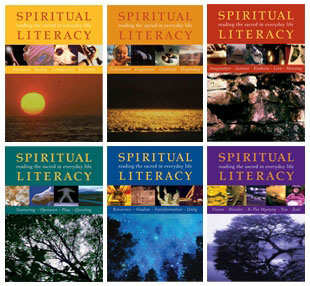 In 1999, a Canadian film company made a television series titled Spiritual Literacy: Reading the Sacred in Everyday Life. It consists of 26 half-hour episodes based on the Alphabet — from Attention to Zeal. The director, David Cherniack, married excerpts from the book with sense-luscious visuals and emotionally vibrant music. After the series aired on VISN-TV in Canada, the Brussats arranged for the episodes to be made available on six DVDs. And just this month, the films became available for rental or download on Vimeo Video-on-Demand.
In 1999, a Canadian film company made a television series titled Spiritual Literacy: Reading the Sacred in Everyday Life. It consists of 26 half-hour episodes based on the Alphabet — from Attention to Zeal. The director, David Cherniack, married excerpts from the book with sense-luscious visuals and emotionally vibrant music. After the series aired on VISN-TV in Canada, the Brussats arranged for the episodes to be made available on six DVDs. And just this month, the films became available for rental or download on Vimeo Video-on-Demand.
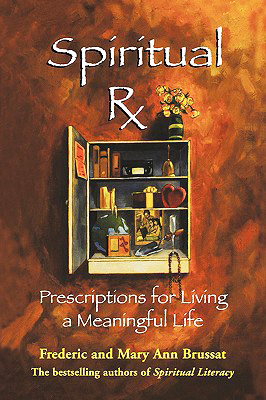 The Alphabet is also the focus on the Brussats' book Spiritual Rx: Prescriptions for Living a Meaningful Life. In 37 chapters, the Brussats identify the best ways to work with each Alphabet practice: key teachers; best books; recommended audios, fiction, poetry, children's books, art pieces, and music selections; related spiritual practices to try; journal and imagery exercises; discussion questions; household and community projects; prayers and mantras; and more. The book provides a multifaith array of more than 500 resources for use on the path of practice.
The Alphabet is also the focus on the Brussats' book Spiritual Rx: Prescriptions for Living a Meaningful Life. In 37 chapters, the Brussats identify the best ways to work with each Alphabet practice: key teachers; best books; recommended audios, fiction, poetry, children's books, art pieces, and music selections; related spiritual practices to try; journal and imagery exercises; discussion questions; household and community projects; prayers and mantras; and more. The book provides a multifaith array of more than 500 resources for use on the path of practice.
Finally, The Alphabet of Spiritual Literacy is central to the organization of the website SpiritualityandPractice.com. All the content on the site is coded to which Alphabet practice it illustrates.
Chapter 5: Spirituality & Practice (2006 - the present)
On the First Day of Spring in 2006, Frederic and Mary Ann Brussat launched a new website, SpiritualityandPractice.com (S&P). They consolidated their content from previous newsletters and website endeavors, establishing sections on spiritual practices, books, films, spiritual teachers, and more.
These areas are still going strong today; S&P visitors can now search more than 2000 spiritual practices, 7300 book reviews, 5000 book excerpts, 5700 film reviews, profiles of 180 spiritual teachers, 12,500 quotes, plus blogs, art and music reflections, and rituals for special days. They have curated their content on the religious and spiritual traditions and set up a section of content on topics, such as climate change, community, monasticism, resilience, and walking. Here's one of the first homepages, and another from 2015 when the website was redesigned at the same time that the Brussats decided to move to Claremont, California, and set up a Center for Spirituality & Practice.
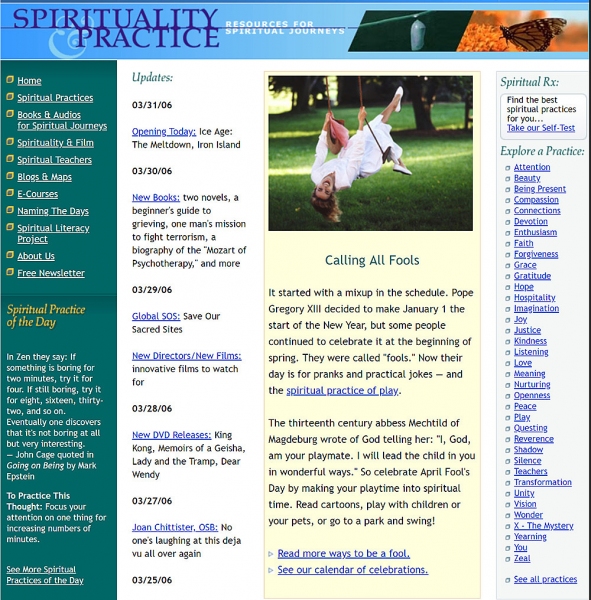
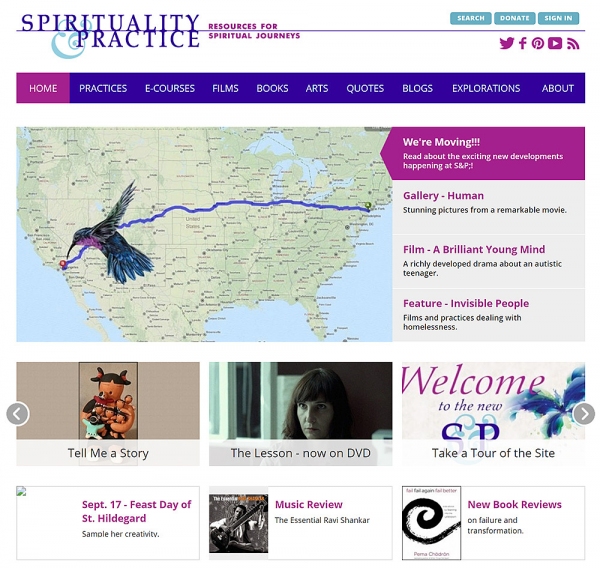
Certain features on the website have turned out to be perennial favorites. Every year, the Brussats give awards to 50 Best Spiritual Books; these annual lists going back to 1998 are still on the website. Also available are lists going back to 1997 of the "Most Spiritually Literate Films" of each year -- more than 50 features, documentaries, foreign language, and animated movies. By relating each film to one of the practices in the Alphabet of Spiritual Literacy, the Brussats have established a broad and useful connection between films people might not consider to be very "spiritual" and the values and visions of our time.
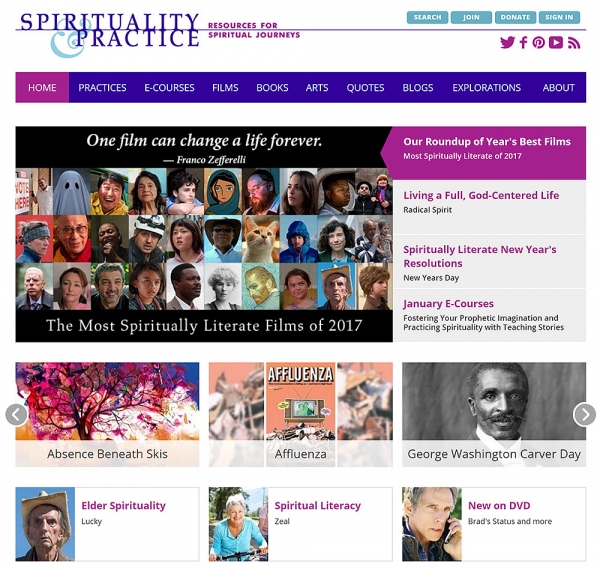
Indeed, making connections is one of the intentions of the website. Mary Ann comments on this chapter of their work:
"It's been really great publishing and distributing reviews and articles via the Internet. Gone are the days when I'd groan spotting a typo in a printed newsletter; if we see a mistake in a piece on Spirituality & Practice, we just go into our Content Management System and fix it! Gone, too, are the days when we'd worry that our coverage of a TV program or movie would arrive too late because of slow mail service; now we can publish on the day of release and know people will have a timely review.
"But one of the real joys of working on Spirituality & Practice is the ability to make connections. From the beginning, Mike Wu and his talented team at Bandwidth Productions, have designed and maintained the site so that our visitors can follow multiple threads of connected content. Say you find a book you like: a link on the author's name takes you to pages on other books, spiritual practices, and quotes by that author; a link on a keyword brings up other resources on that subject; a link to a tradition page shows you practices, teachers, and other recommended resources for that religion; and a link to the Related Practices takes you to pages showing many different ways to practice the Alphabet of Spiritual Literacy. It's possible to design your own spiritual education just by following links at S&P.
"We've worked hard to make these connections, taking the time with each piece of content to make our coding helpful to our visitors. The great Buddhist teacher Thich Nhat Hanh once said, 'We are here to awaken from the illusion of our separateness.' It's wonderful to be able to support that quest with our website."
This chapter of the Brussats' career has also been characterized by collaboration. S&P's "School of Spiritual Life" consisting of online courses began with a series of "Practicing Spirituality" e-courses the Brussats developed themselves; they designed daily practices based on quotes from books about the religions and everyday activities as well as a series on the writings of master teachers. To broaden the program, they reached out to spiritual teachers who were interested in teaching online and interacting with a worldwide community in a "Practice Circle." (Below is a picture of some of the teachers who have taught via S&P). Organizations such as Contemplative Outreach, A Network for Grateful Living, The Threshold Society, Sage-ing International, Benetvision, and the Spiritual Paths Institute joined with S&P to develop e-courses and reach new audiences.
To date, more than 200 courses are available on-demand at S&P and more are offered every month. For those who do not have the extra time or extra money to go away to a retreat center, S&P has been able to bring flexible and affordable retreats right to people's email inboxes.
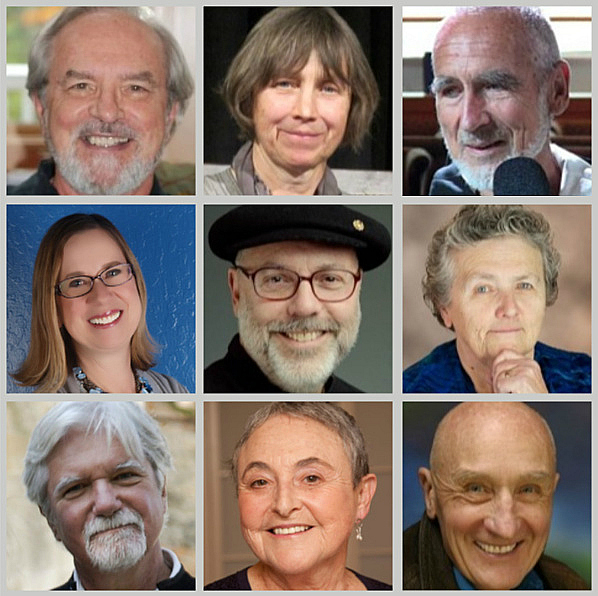
Over the years, CIStems, Inc., the 501(c) (3) nonprofit organization the Brussats founded, has been blessed to receive the support of foundations to partially fund their work, including the Irwin-Sweeney-Miller Foundation, the Grants Program of Trinity Church Wall Street, the Lilly Endowment, and the Kalliopeia Foundation.
Spirituality & Practice has especially enjoyed a collaborative relationship with the Fetzer Institute. Interested in how spiritual conversations could take place in a variety of local settings and online, Fetzer helped S&P set up pilot projects around the Spiritual Literacy DVDs and then enabled us to program the website's forums to host e-course Practice Circles. As S&P began to curate its content into special projects, Fetzer took an interest in The Reverence Project. Today Fetzer and S&P are collaborating on The Practicing Democracy Project, where we are identifying spiritual practices and resources to support a flourishing democracy.
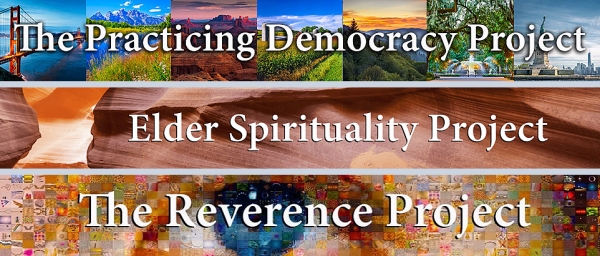
What happens now that the Brussats have worked together for 50 years? Although they have no plans for an immediate retirement, they are doing legacy work, and we have some specific plans for the Anniversary Fund. And knowing Frederic and Mary Ann, they will probably come up with some other ideas as we all move forward.
Be Part of this Ongoing Venture
You can see that Frederic and Mary Ann take seriously Dr. Seuss's words in The Lorax:
"Unless someone like you cares a whole awful lot,
Nothing is going to get better. It's not."
Your support helps make their continued dedicated engagement possible.
When you give to our "Brussat Anniversary Fund" you also support the development of a training program in transformative practices for spiritual and nonprofit leaders. You enable Spirituality & Practice to recruit more reviewers and contributors. And you make it possible for us to offer a free daily email service of our Spiritual Practices of the Day. Thank you so much in advance for giving as generously as you are able.
Gratefully,
Patricia Campbell Carlson
Program Director and Senior Editor
Margaret E. Wakeley
Creative Director Spirituality and Practice